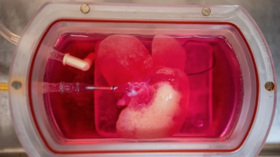Scientists SUCCESSFULLY transplant mini HUMAN livers into RATS

Researchers have successfully tested potentially revolutionary technology which could spell the beginning of an organ-donor-free future – after they successfully grew and transplanted miniature human livers… into rats.
University of Pittsburgh scientists cultured those mini organs from reprogrammed human skin cells. In just a matter of weeks, the researchers were able to achieve maturation of those livers – a process that would normally take up to two years in full-sized livers. They then seeded the grown cells on a rat liver, using the animal’s vascular system and bile duct network to maintain them as they populated the remaining functional rat liver tissue.

In total, the miniature human organs were transplanted into five rats, all of which showed proper, though somewhat flawed, organ function up until they were dissected on day four of the experiment. However, the rats still showed signs of complications such as thrombosis or ischemia – which shows that the technique still requires a lot of research and development.
The researchers, though, remain optimistic and believe we are a decade away from human trials of such a technique. In the longer term, this technology could pave the way for new advanced techniques to treat terminal liver failure while dramatically reducing transplant waiting lists and associated fatalities.
“I believe it’s a very important step because we know it can be done,” pathologist Alejandro Soto-Gutierrez from Pittsburgh University explained to Inverse. “You can make a whole organ that can be functional from one cell of the skin.”
“The long-term goal is to create organs that can replace organ donation, but in the near future, I see this as a bridge to transplant,” Soto-Gutierrez said. “For instance, in acute liver failure, you might just need hepatic boost for a while instead of a whole new liver.”
Also on rt.com Lab-grown HUMAN ‘mini-brains’ learned to control musclesSome 14,000 US citizens are awaiting liver transplants at any given time, while liver failure kills roughly 40,000 people in the US annually.
For those fortunate enough to make it to the top of the list, liver transplants cost somewhere in the region of $812,500 (based on data from 2017), including pre- and post-op care and the necessary immunosuppressant medications to keep the body from rejecting the transplanted organ.
Like this story? Share it with a friend!














